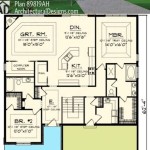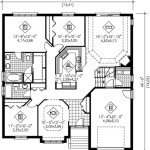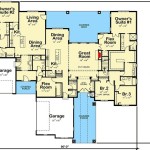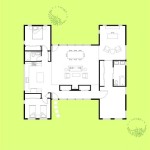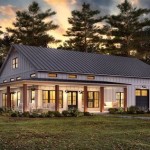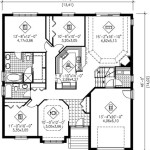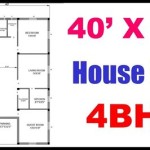Single-Family Homes Floor Plans: A Guide to Designing Your Dream Home
A single-family home floor plan serves as the blueprint for your future dwelling. It outlines the layout, dimensions, and functionality of your home, dictating the flow of spaces and the overall feel of living there. Choosing the right floor plan is crucial, as it will impact your daily routines, the way you entertain guests, and the overall comfort and functionality of your home. To navigate this process effectively, understanding the key elements of a single-family home floor plan is essential.
Understanding the Basics of a Floor Plan
A single-family home floor plan typically depicts a bird's-eye view of each level of the house. It includes walls, doors, windows, staircases, and the placement of major fixtures like bathrooms, kitchens, and fireplaces. Detailed floor plans may also include the measurements of each room, the thickness of walls, and the location of electrical outlets and plumbing lines. Understanding the symbols used on a floor plan is crucial for interpreting the layout. These symbols usually represent different elements like doors, windows, cabinets, and appliances.
Key Factors to Consider in Single-Family Home Floor Plans
When selecting a floor plan, several key factors influence the decision, including:
1. Lifestyle Needs:
Consider your family's lifestyle and needs. If you enjoy entertaining, a spacious living area and dining room are essential. For families with children, dedicated play areas and bedrooms with adequate space for growing kids are vital. If you work from home, a home office or dedicated workspace might be a priority.
2. Number of Bedrooms and Bathrooms:
The number of bedrooms and bathrooms is a significant factor. Consider your current needs and future plans. For growing families or those planning to age in place, a home with extra bedrooms and bathrooms may be preferable.
3. Open Floor Plans vs. Traditional Layout:
Open floor plans, characterized by fewer walls and a more integrated flow between spaces, offer a sense of spaciousness and connectivity. Traditional layouts, with defined rooms and closed-off spaces, provide more privacy and separation. Your preferred living style will dictate the choice between these two approaches.
4. Flow and Functionality:
The flow of the floor plan impacts the functionality of your home. A well-designed layout facilitates daily routines, making it easy to move between spaces without feeling cramped or obstructed. Consider the placement of kitchens, bathrooms, laundry rooms, and other essential areas for optimal convenience.
5. Natural Light and Ventilation:
The placement of windows and doors influences natural light and ventilation. A well-lit and well-ventilated home enhances comfort and energy efficiency. Consider how sunlight flows through the house at different times of day and ensure adequate ventilation for each room.
Types of Single-Family Home Floor Plans
Various floor plan styles cater to different needs and preferences. Some common types include:
1. Ranch Style:
Ranch-style homes feature single-story living, with a spacious, open floor plan and often a wider, more rectangular footprint. They are popular for their accessibility and ease of movement, particularly for aging homeowners or families with young children.
2. Two-Story:
Two-story homes offer vertical living, maximizing space on a smaller footprint. Typically, they include a living area, kitchen, and dining room on the first floor and bedrooms and bathrooms on the second floor. Two-story homes provide a sense of privacy and separation between living and sleeping areas.
3. Split-Level:
Split-level homes add a different dimension to the design. They feature staggered levels, often with a sunken living room or family room, and bedrooms located on a slightly higher level. They provide an interesting architectural element and can accommodate a variety of needs.
4. Contemporary:
Contemporary homes emphasize open spaces, integrated living areas, and a focus on maximizing natural light. They typically feature clean lines, minimal ornamentation, and a focus on functionality. Contemporary floor plans often include unique features like vaulted ceilings, oversized windows, and indoor-outdoor living spaces.
Tips for Reviewing Single-Family Home Floor Plans
When reviewing floor plans, consider these tips:
1. Visualize the Space:
Imagine yourself moving through the space, using the different rooms, and interacting with furniture. Can you see yourself comfortably living in the home?
2. Analyze Traffic Flow:
Trace the paths you would take for daily activities, such as preparing meals, going to bed, or welcoming guests. Are the walkways wide enough? Are there any potential choke points or awkward transitions?
3. Consider Storage Needs:
How much storage space do you need? Are there designated areas for closets, pantries, or built-in shelves?
4. Think About Future Needs:
Consider your future needs and preferences. Would you want to age in place? Will you need to accommodate a growing family?
5. Seek Professional Guidance:
Consulting an architect or interior designer can provide valuable insights and help you make informed decisions about the best floor plan for your needs.

Today S New Single Family Homes Building Bigger For A Forever Residence

Unique One Story House Plans Monster

Single Family Small House Plans Floor Photos

Top 10 Duplex Plans That Look Like Single Family Homes Houseplans Blog Com

Must Have One Story Open Floor Plans Blog Eplans Com

Top 10 Duplex Plans That Look Like Single Family Homes Houseplans Blog Com
Must Have One Story Open Floor Plans Blog Eplans Com

Unique One Story House Plans Monster

Affordable Single Family Detached Home Designs Pro Builder

Single Family Floor Plan For Habitat Humanity Evstudio


